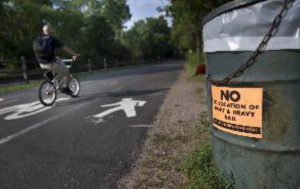The following article by Pat Doyle was published in the March 12, 2014 issue of the StarTribune:
SOUTHWEST LIGHT-RAIL PLANNERS WOO MINNEAPOLIS CRITICS WITH NEW TUNNEL IDEA

The Cedar Lake Trail alongside a current freight train track that has been a proposal site for the Southwest Corridor light rail line in St. Louis Park, Minn.
Photo by Renee Jones Schneider
In an effort to win over Minneapolis critics of the Southwest Light Rail project, its planners are pursuing spending more money to hide the transit in tunnels under a water channel and as well as underground in a recreational corridor near the Chain of Lakes.
The latest option on the table would add as much as $85 million to the cost of the project, potentially bringing it to over $1.6 billion.
The Metropolitan Council, the agency overseeing the light rail project, unveiled the new tunnel option Wednesday at a meeting of metro leaders where it received a cautious reception from Minneapolis officials.
“I really have to talk to my boss,” said Peter Wagenius, the top policy aide to Minneapolis Mayor Betsy Hodges.
“It’s potentially helpful,” said Hennepin County Commissioner Peter McLaughlin.
The proposed Southwest line, which would run from Minneapolis to Eden Prairie, has been jeopardized by a dispute between Minneapolis and St. Louis Park over rerouting freight trains to make room for the light-rail line in the Kenilworth corridor of Minneapolis.
Minneapolis earlier rejected a Met Council proposal to spend $160 million to build two light-rail tunnels on either side of the water channel connecting Lake of the Isles and Cedar Lake and have the transit surface to cross a bridge over the channel. Instead, the city insisted on rerouting the Twin Cities & Western freight from the Kenilworth corridor to a neighborhood in St. Louis Park.
Homeowners along the corridor objected to light-rail trains crossing a bridge over the channel, complaining it would be unsightly.
An earlier option for tunneling under the channel was rejected last year by metro leaders because it would have contributed $330 million to the cost of the project.
Plan would add a year to project
The latest Met Council version would cost less because it would be built by walling off the creek rather than burrowing beneath it and wouldn’t be as deep.
But it has drawbacks beyond being more expensive than running the light rail over the channel. It would add another year to construction of the project, likely delaying the opening of the Southwest line until 2019. And the channel, used by water sports enthusiasts, would be shut down for a year.
Met Council engineers said the cost of tunneling under the channel could be cut to $40 million if the tunnel were shortened substantially north of the tunnel, bring the light-rail trains to the surface earlier. That plan would allow for a station at ground level at 21st Street. But some homeowners in the area don’t want a station or the light-rail line at ground level.
The new tunnel schemes are expected to be discussed in more detail later this month by the metro leaders.
Matthew Look, an Anoka County commissioner who sits on a panel that bankrolls transit projects, was cool to the idea Wednesday and renewed a call to consider a much cheaper option of moving bike and pedestrian trails from the corridor to make room for both light-rail and freight trains at ground level. The city of Minneapolis has rejected that idea.
Homeowners along the Kenilworth corridor, including influential DFLers, asked the Met Council staff last year to investigate a cheaper option for putting the light-rail line in tunnels under the channel. The Met Council said at the time that it wasn’t pursuing the idea.
But the Minneapolis Park and Recreation Board, which has authority over park areas in the corridor, recently pressed the agency to investigate the possibility.
“We felt compelled to take a closer look at it,” Mark Fuhrmann, who oversees transit development for the Met Council, said Wednesday.
